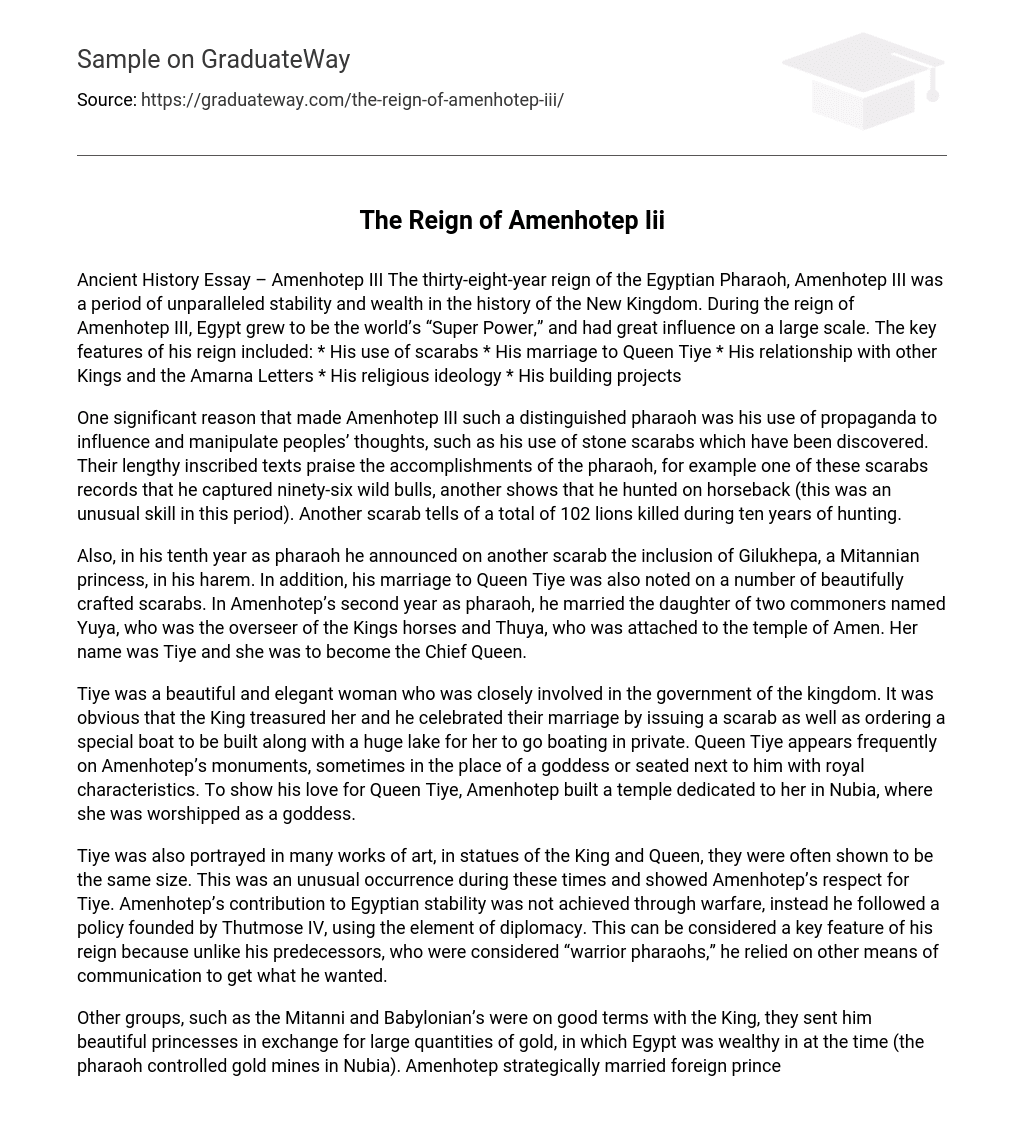Ancient History Essay – Amenhotep III was a Pharaoh of Egypt during the New Kingdom. His thirty-eight-year reign marked a time of remarkable stability and prosperity. Under Amenhotep III, Egypt became a dominant global power and exerted significant influence. Some notable aspects of his rule encompassed his employment of scarabs, his union with Queen Tiye, his interactions with other kings as depicted in the Amarna Letters, his religious beliefs, and his extensive construction endeavors.
One of the main factors that contributed to Amenhotep III’s exceptional reign as pharaoh was his skillful utilization of propaganda to shape and control public opinions. Evidence of this can be found in the stone scarabs that have been unearthed. These scarabs contained extensive inscriptions that glorified the pharaoh’s achievements. For instance, one scarab documented his capture of ninety-six wild bulls, while another highlighted his exceptional horseback hunting skills, a rarity during that era. Additionally, a scarab commemorated the impressive feat of killing 102 lions over a period of ten years.
In his tenth year as pharaoh, Amenhotep announced the inclusion of Gilukhepa, a Mitannian princess, in his harem on another scarab. Additionally, his marriage to Queen Tiye was documented on several finely crafted scarabs. In his second year as pharaoh, Amenhotep married Tiye, the daughter of two commoners named Yuya and Thuya. Yuya was the overseer of the Kings horses, while Thuya was attached to the temple of Amen. Tiye would later become the Chief Queen.
Tiye, a beautiful and elegant woman, played a significant role in the government of the kingdom. It was evident that the King cherished her, commemorating their marriage by issuing a scarab and commissioning the construction of a special boat and a large private lake for her recreational boating. Queen Tiye is commonly depicted on Amenhotep’s monuments, often replacing a goddess or seated beside him with regal attributes. In a display of his love for Queen Tiye, Amenhotep erected a temple in Nubia dedicated to her worship as a goddess.
Tiye appeared in numerous pieces of artwork, with statues depicting both the King and Queen as equals in size. This was an uncommon representation during that era, serving as a testament to Amenhotep’s high regard for Tiye. Unlike his predecessors who were known as “warrior pharaohs” and achieved stability through warfare, Amenhotep adopted a diplomatic approach to ensure Egyptian stability. Following the path set by Thutmose IV, Amenhotep relied on communication and negotiation rather than military might to fulfill his objectives.
Other groups, such as the Mitanni and Babylonian’s, had a favorable relationship with the King. They would send him princesses in exchange for gold, which Egypt had in abundance due to its control of gold mines in Nubia. Amenhotep married foreign princesses strategically to strengthen his alliances and prevent war. The Amarna letters, clay tablets, played a crucial role in Amenhotep’s success by serving as evidence of his diplomatic skills through correspondence with different royal courts.
These letters were famous for containing treaties between Egypt and its enemies, making it one of Amenhotep’s greatest achievements as ruler of New Kingdom Egypt and contributing to the country’s prosperous “Golden Age.” Another significant aspect of Amenhotep’s reign was his religious beliefs. While he worshipped multiple gods, he held a strong attachment to Amun-Re. Amenhotep generously donated considerable portions of his wealth to both the temples and priests of Amun-Re. Initially, these contributions brought him favorable outcomes, but as he continued giving, the priests grew increasingly powerful and began to challenge his authority.
Queen Tiye was closely connected to the worship of both Amun-Re and the Aten, a variant of the sun god. Her husband, Amenhotep, also encouraged the growing devotion to the Aten. They named their firstborn daughter Baketaten, which translates to “servant of the Aten.” To further demonstrate his dedication, Amenhotep named the ship he constructed for Queen Tiye “The Aten Gleams” and financed her shrine dedicated to the Aten. Later on, their son and successor, Ahkenaten, further advanced the practice of worshipping this god alone.
Amenhotep III dedicated significant resources to his construction projects. One notable structure is the Mortuary temple, crafted from white sandstone and adorned with gold and silver. It also showcased numerous royal statues comprised of various precious stones. Positioned at the temple’s entrance were two enormous statues of the pharaoh, famously called the Colossi of Memnon, named by the Greeks in reference to a Greek hero. Beyond these impressive edifices, Amenhotep’s palace at Malkata, constructed from mud-brick and wood, captivated many. The palace featured remarkable paintings, intricately designed cornices, vibrant glazed tiles, and painted floors. Adjacent to the palace at Malkata, the pharaoh designed a vast harbor with a canal leading to the Nile. Additionally, Amenhotep manifested his devotion to the gods by erecting numerous religious monuments, which included a spacious courtyard and shrine at the temple of Amen and Mut, as well as an avenue of sphinxes connecting the temple to Karnak.
During his later years, Amenhotep dedicated himself to creating 600 life-size statues of Sekhmet, a lion-headed goddess. This resulted in a period of exceptional stability and wealth throughout Amenhotep III’s reign. The pharaoh’s extraordinary diplomatic strategy, religious beliefs, and architectural genius were the main elements that contributed to this stability and prosperity. In combination, these characteristics established Amenhotep III as one of the most renowned pharaohs in Egyptian history and ushered in the country’s “Golden Age.”





